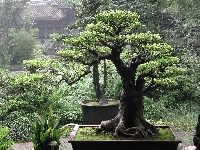
To grow bonsai trees you need plants, patience and pruning
The name bonsai means “tray plant” or “little trees in pots” and the beauty of these miniature trees is both delightful and mysterious. First grown in China and popularized in Japan, growing and training bonsai trees and shrubs is an interesting hobby that has spread worldwide. With some guidelines on what you need to grow bonsai and tips on training and pruning, anyone can join in the fun without the need of a tiny green thumb.
The quickest and easiest way to get started in bonsai growing is with a professionally trained and trimmed plant. One surprising fact to people new to bonsai is that most are outdoor plants. While some tropical varieties can thrive indoors, most do best outside. Sago palms, ficus and jade are good choices for indoors.
Depending on your weather, outdoor selections include evergreens, elms, flowering plants and even fruit trees. Your first instinct is to go with plants that have the look and style you like, but it’s important to consider the sun and shade patterns of your yard or plant room. Since bonsai plants are potted, it’s easy to move them for seasonal and weather changes. Consult your plant dealer’s website, a nursery, bonsai books or a fellow bonsai grower for tips.
If you start with a bonsai that it still in the training stage, you’ll need to keep it in a training pot. These are larger than display pots and have screened holes for proper irrigation and drainage. You will be re-potting your plant frequently to trim the roots and change the soil. Roots on the surface, called nebari, are trimmed for looks while the unseen lower roots are pruned to restrict growth.
The trunk is by far the most visual part of a bonsai tree so choose your plant with a well-formed trunk that will give the aura of age. Use scissors that are sharp and clean and pliers that are comfortable to shape and taper the trunk, trim branches and remove foliage. Other useful tools are rakes and wire benders. Wiring is the next step in shaping the trunk and branches and controlling growth, giving bonsais a wide variety of styles from upright to slanted to windswept.
To keep your bonsai healthy in both training and final display, it’s important to keep the soil fresh and watered. Daily watering is recommended, wetting the soil slowly using room temperature tap water from a sprinkler until it runs from the bottom holes. Use the bonsai soil recommended for your plant and change it when it becomes hard. Bonsai also need fertilizer regularly, usually an equal mix of nitrogen, phosphorous and potassium at a reduced strength.
Once your bonsai has the look and shape you want, move it to a display pot. This is the time to add accessories to accentuate the looks of your tiny garden or forest. Putting the pot on a stand can give the plant more visibility. Move your plant depending on temperature and shade and be prepared to wrap the pot and move it to a place with less exposure to the elements in the winter.
Talk to other bonsai growers, research Internet sites and visit nurseries specializing in them. All will agree that what you need most to grow bonsai is patience and a love of caring for these beautiful living works of art.

